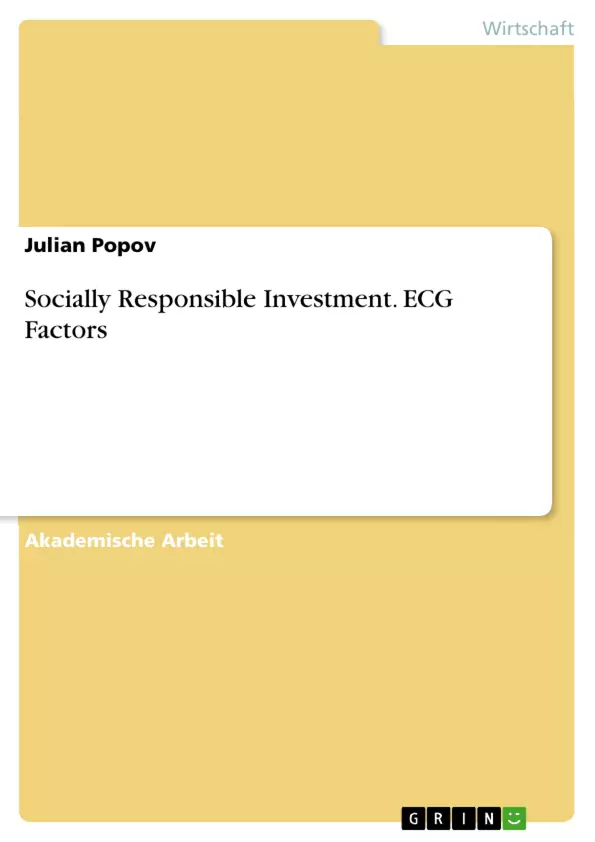Investors talk about increasing profits, minimising transaction costs or how to evade taxes most effectively, but very few investors consider if the company contributes something to society, treats employees with respect or tries to reduce harm to environment; in fact - they do not invest socially responsible. But what is socially responsible and how can firms be obtained which make the grade?
This essay provides a short overview about the history of Socially Responsible Investing (SRI) and its terminology. Furthermore, different investment strategies are explained in order to understand the depth and the variety of possibilities using these strategies. Knowing these facts, the main reason for investors to invest lies within the nature of things: the return. Every good intention will be flood by the opposite, if the good intention does not perform well and the sinner stocks achieve excess returns. The overall opinion about SRI and the most common theory is that the SRI approach is underperforming the market, as the investor is restricted in stock selection, which decreases the possible level of diversification eventually leading to a lower risk-return level.
But do SRI portfolios underperform the market, respectively the "Sin Stocks"? Moreover, this paper tries to use statistical approaches to approve or disapprove the abovementioned theory. By regressing the returns of the biggest social index, the KLD 400, against the returns of the S&P500 and the biggest Sin Stocks Fund, called VICEX, an informed choice will be possible. Furthermore, the investment approaches will be analysed in the overall context of their long-term performance and possible explanations for under- and overperformance. In addition, this essays appendix provides an approach of investing, fulfilling the criteria of SRI and the ESGs, which stands for environmental, social and corporate governance criteria. This project deals with the increasing amount of refugees coming to Germany and the consequent lack of real estate supply. This lack of supply causes difficulties regarding the integration process, which will eventually lead to a separation of the community and increasing appeal of right wing populists.
Inhaltsverzeichnis
- I. Einleitung
- II. Was ist sozial verantwortliches Investieren?
- A. Terminologie
- B. Geschichte
- C. Strategien
- 1. Negatives Screening
- 2. Aktionärsaktivismus
- 3. Positives Investieren
- 4. Impact Investing
- III. Relative Performance von SRI-Portfolios
- IV. Deduktion
Zielsetzung und Themenschwerpunkte
Diese Arbeit befasst sich mit dem Konzept des sozial verantwortlichen Investierens (SRI) und analysiert die relative Performance von SRI-Portfolios im Vergleich zu traditionellen Portfolios.
- Definition und Entwicklung des SRI
- Analyse verschiedener SRI-Strategien
- Bewertung der Performance von SRI-Portfolios
- Untersuchung der Auswirkungen von SRI auf die Gesellschaft
- Ethische und praktische Aspekte des SRI
Zusammenfassung der Kapitel
I. Einleitung
Die Einleitung stellt das Thema des sozial verantwortlichen Investierens vor und beleuchtet die Debatte um die Performance von SRI-Portfolios.
II. Was ist sozial verantwortliches Investieren?
Dieses Kapitel definiert den Begriff des SRI und seine verschiedenen Facetten. Es beleuchtet die historische Entwicklung des SRI und erläutert verschiedene Strategien, die von SRI-Investoren angewendet werden.
III. Relative Performance von SRI-Portfolios
Dieses Kapitel analysiert die Performance von SRI-Portfolios im Vergleich zu traditionellen Portfolios. Es wird untersucht, ob SRI-Portfolios tatsächlich schlechter abschneiden als der Markt.
Schlüsselwörter
Sozial verantwortliches Investieren (SRI), nachhaltiges Investieren, ESG-Kriterien, relative Performance, Portfoliomanagement, ethische Investitionen, Impact Investing, Aktionärsaktivismus, Negatives Screening, Positives Investieren.
- Citation du texte
- Julian Popov (Auteur), 2017, Socially Responsible Investment. ECG Factors, Munich, GRIN Verlag, https://www.grin.com/document/412287



